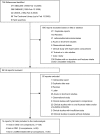Heterogeneous effects of fructose on blood lipids in individuals with type 2 diabetes: systematic review and meta-analysis of experimental trials in humans
- PMID: 19592634
- PMCID: PMC2752906
- DOI: 10.2337/dc09-0619
Heterogeneous effects of fructose on blood lipids in individuals with type 2 diabetes: systematic review and meta-analysis of experimental trials in humans
Abstract
Objective: Because of blood lipid concerns, diabetes associations discourage fructose at high intakes. To quantify the effect of fructose on blood lipids in diabetes, we conducted a systematic review and meta-analysis of experimental clinical trials investigating the effect of isocaloric fructose exchange for carbohydrate on triglycerides, total cholesterol, LDL cholesterol, and HDL cholesterol in type 1 and 2 diabetes.
Research design and methods: We searched MEDLINE, EMBASE, CINAHL, and the Cochrane Library for relevant trials of > or =7 days. Data were pooled by the generic inverse variance method and expressed as standardized mean differences with 95% CI. Heterogeneity was assessed by chi(2) tests and quantified by I(2). Meta-regression models identified dose threshold and independent predictors of effects.
Results: Sixteen trials (236 subjects) met the eligibility criteria. Isocaloric fructose exchange for carbohydrate raised triglycerides and lowered total cholesterol under specific conditions without affecting LDL cholesterol or HDL cholesterol. A triglyceride-raising effect without heterogeneity was seen only in type 2 diabetes when the reference carbohydrate was starch (mean difference 0.24 [95% CI 0.05-0.44]), dose was >60 g/day (0.18 [0.00-0.37]), or follow-up was < or =4 weeks (0.18 [0.00-0.35]). Piecewise meta-regression confirmed a dose threshold of 60 g/day (R(2) = 0.13)/10% energy (R(2) = 0.36). A total cholesterol-lowering effect without heterogeneity was seen only in type 2 diabetes under the following conditions: no randomization and poor study quality (-0.19 [-0.34 to -0.05]), dietary fat >30% energy (-0.33 [-0.52 to -0.15]), or crystalline fructose (-0.28 [-0.47 to -0.09]). Multivariate meta-regression analyses were largely in agreement.
Conclusions: Pooled analyses demonstrated conditional triglyceride-raising and total cholesterol-lowering effects of isocaloric fructose exchange for carbohydrate in type 2 diabetes. Recommendations and large-scale future trials need to address the heterogeneity in the data.
Figures


References
-
- Executive Summary of The Third Report of The National Cholesterol Education Program (NCEP) Expert Panel on Detection, Evaluation, and Treatment of High Blood Cholesterol in Adults (Adult Treatment Panel III). JAMA 2001;285:2486–2497 - PubMed
-
- Sarwar N, Danesh J, Eiriksdottir G, Sigurdsson G, Wareham N, Bingham S, Boekholdt SM, Khaw KT, Gudnason V: Triglycerides and the risk of coronary heart disease: 10,158 incident cases among 262,525 participants in 29 Western prospective studies. Circulation 2007;115:450–458 - PubMed
-
- Lorenzo C, Williams K, Hunt KJ, Haffner SM: The National Cholesterol Education Program-Adult Treatment Panel III, International Diabetes Federation, and World Health Organization definitions of the metabolic syndrome as predictors of incident cardiovascular disease and diabetes. Diabetes Care 2007;30:8–13 - PubMed
-
- Bantle JP, Wylie-Rosett J, Albright AL, Apovian CM, Clark NG, Franz MJ, Hoogwerf BJ, Lichtenstein AH, Mayer-Davis E, Mooradian AD, Wheeler ML: Nutrition recommendations and interventions for diabetes: a position statement of the American Diabetes Association. Diabetes Care 2008;31(Suppl. 1):S61–S78 - PubMed
-
- Canadian Diabetes Association 2008 clinical practice guidelines for the prevention and management of diabetes in Canada. Can J Diabetes 2008;32:S1–S201 - PubMed
Publication types
MeSH terms
Substances
LinkOut - more resources
Full Text Sources
Medical
Miscellaneous

